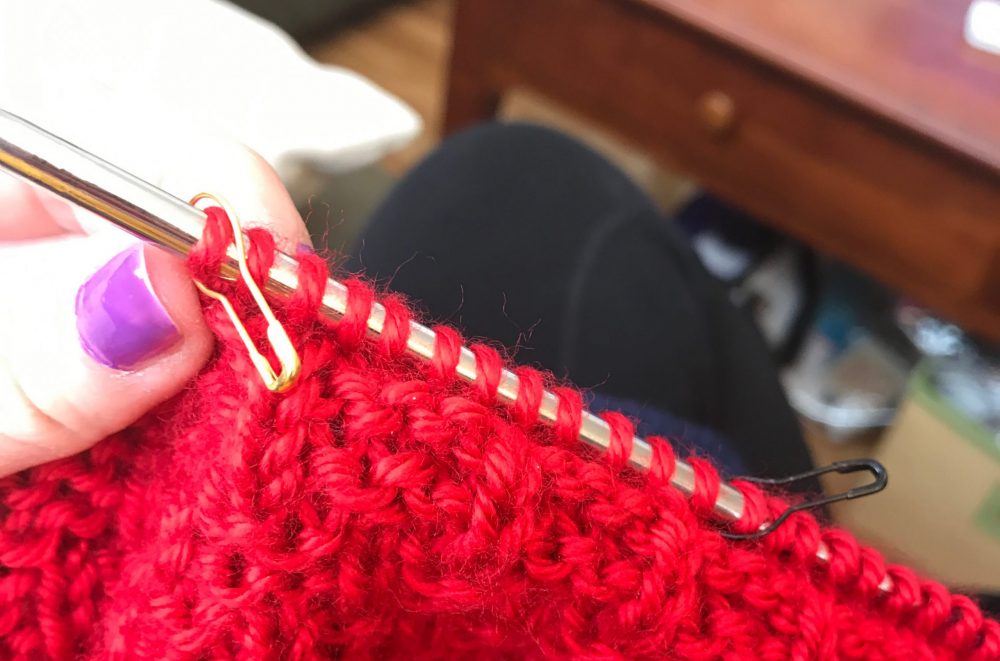Heads up! This post contains affiliate links which means I get may get a commission if you purchase something based on my recommendations here.
I remember sitting in 9th grade geometry class thinking: “When am I ever going to use this in real life?” Still, I dutifully committed the Pythagorean Theorem to memory and, what do you know? Thirty-five years later, I still remember that sucker and it makes a lovely addition to my knitting toolkit.
So, here’s the story: I’m knitting the fabulous Purl Soho Easy Puzzle Blanket for a pal’s baby, but I got a bit of a delayed start, so I wanted to speed up the knitting by working it up in worsted weight yarn instead of fingering… and that set me up for a serious math adventure.
This blanket has a modular design and it’s knitted in four triangular sections. Purl Soho provided a wonderful schematic of the blanket that labels the finished measurements of the sides of the blanket, but they didn’t provide the length of the cast on edge of the starting triangle, which is the measurement I needed to scale the pattern.
So, I know what you’re thinking: I can’t use the Pythagorean Theorem with only the hypotenuse to work from!?! (That’s totally what you were thinking, right?) IDK, there’s probably a way to do it since it’s a right isosceles triangle, but I don’t need to get that mathy, because I’m not just working with a single triangle, I’m working with four triangles that form a square, so I really just need to solve for the diagonal of the square and divide it in half, and there is a super simple derivation of the PT that can get us that number: d = √2 * a.
I used my adorable No Skein, No Gain knitter’s pencil to work the equation, but you can totally just google “calculate the diagonal of a square” and you’ll get a nifty calculator right in the search results.
So, I pop 30.75” into the formula as the side of my square and I get back a diagonal of 43.49” which I divide by two to get a length of 21.75”. Now I just need to know how many stitches to cast on to get a 21.75” edge. We all know what to do: knit a gauge swatch!!
I hope you’ve stuck with me this far because I’m about to share a mind-blowing tip for measuring your gauge swatch that is gonna be a game changer in your knitting.
Ready?
Put your swatch on a flat surface and set your ruler on it. I love this clear EZ PZ gauge ruler, but any gauge tool or ruler will work. Now, grab your phone and take a picture of the ruler on your swatch and count the stitches on your screen! I use edit mode to set the contrast to max, and then I use the little markup tool to cross off each stitch once I count it, all while zooming in on the swatch to my little heart’s content. Try it and you’ll never go back to trying to count stitches off the swatch itself.
Now, back to the math:
I’ve got 19 stitches over 4 inches, or, 4.75 stitches per inch. Now I just multiply 4.75 by my desired cast on length of 21.75”, and I get 103.3 stitches. I want to cast on an even number for this pattern, so I rounded up to 104 stitches.
Now that I’ve matched up my gauge to the official pattern dimensions, I can knit the rest of it using the lengths specified for each color block.
I hope this was helpful for anyone else who is trying to substitute yarns in this fun free baby blanket pattern!
In conclusion, just count how many stitches you have per inch and multiply that number by 21.75 to figure out how many stitches to cast on for your crib-size Easy Puzzle Blanket. Round up or down so you cast on an even number.
Shout out to my geometry teacher, Mr. Chadderdon! Go Ligers!







Leave a Comment